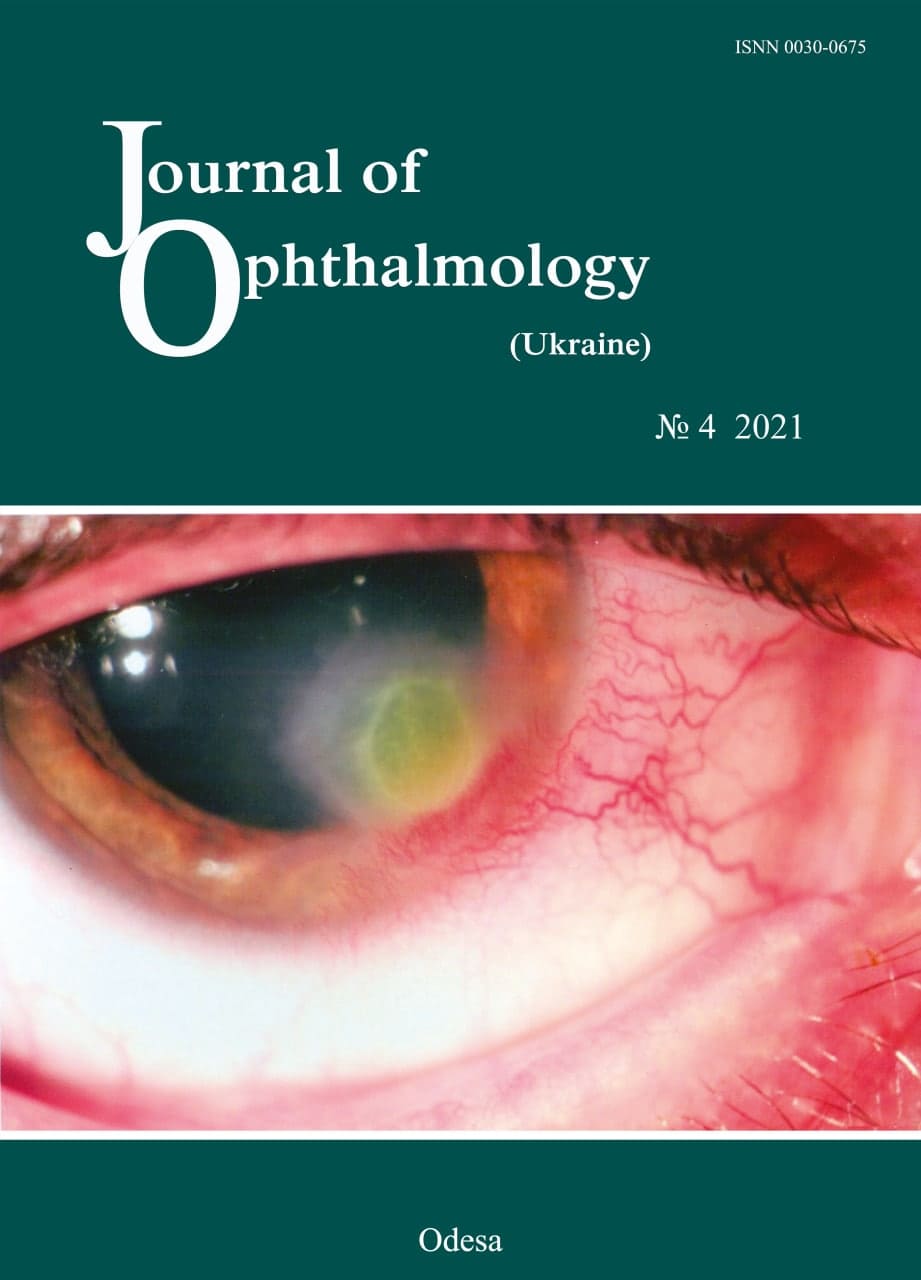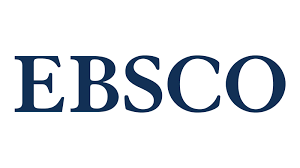The relation between Eyelid Tumors and Demographic Variable
DOI:
https://doi.org/10.31288/oftalmolzh202145760Ключові слова:
basal cell carcinoma, dermoid cyst, eyelid, intradermal nevus, squamous cell carcinomaАнотація
Aims: This study evaluated the relationship between demographic variables, location, histopathologic results with Eyelid Tumors in Labbafinejad hospital in Tehran from 2010 to 2020.
Methods and Material: The t-test and analysis of variance were used for comparison of normally distributed variables among groups.
Results: The study was performed on 97 men and 115 women, in which we found 88 cases of benign tumors and 124 cases of malignant tumors. The mean age of the patients was 51.04± 22.9 years ranged between 1- 89. The topography analysis of lesions showed the frequency of locations: 98 cases at the lower eyelid, 112 cases at the upper eyelid, and 2 on both sides, 107 cases at the right eyelid, 101 cases at the left eyelid, and 4 in both eyelids. We realized that basal cell carcinoma was the most frequent malignancy reported, followed by squamous cell carcinoma, whereas intradermal nevus and dermoid cyst made up most of the benign lesions, respectively. Our data also demonstrated a significant difference in the number of men diagnosed over women with basal cell carcinoma.
Conclusions: In this study, 54.8% of lesions were malignant, found mostly in men. The top two types of malignant tumors were basal cell carcinoma and squamous cell carcinoma, and the most frequent benign lesions were intradermal nevus and dermoid cyst, respectively.
Посилання
1.Eren MA, Gunduz AK. Demographic features and histopathological diagnosis in primary eyelid tumors: results over 19 years from a tertiary center in Ankara, Turkey. Int J Ophthalmol 2020;13(8):1287-1293. https://doi.org/10.18240/ijo.2020.08.16
2.Szewczyk M, Pazdrowski J, Golusinski P, et al. Basal cell carcinoma in farmers: an occupation group at high risk. Int Arch Occup Environ Health 2016;89(3):497-501.https://doi.org/10.1007/s00420-015-1088-0
3.Shi Y, Jia R, Fan X. Ocular basal cell carcinoma: a brief literature review of clinical diagnosis and treatment. Onco Targets Ther 2017;10:2483-2489.https://doi.org/10.2147/OTT.S130371
4.Situm M, Buljan M, Bulat V, Lugovic Mihic L, Bolanca Z, Simic D. The role of UV radiation in the development of basal cell carcinoma. Coll Antropol 2008;32 Suppl 2:167-70. (https://www.ncbi.nlm.nih.gov/pubmed/19138022).
5.Yu SS, Zhao Y, Zhao H, Lin JY, Tang X. A retrospective study of 2228 cases with eyelid tumors. Int J Ophthalmol 2018;11(11):1835-1841. DOI: 10.18240/ijo.2018.11.16.https://doi.org/10.18240/ijo.2018.11.16
6.Yin VT, Merritt HA, Sniegowski M, Esmaeli B. Eyelid and ocular surface carcinoma: diagnosis and management. Clin Dermatol. 2015 Mar-Apr;33(2):159-69.https://doi.org/10.1016/j.clindermatol.2014.10.008
7.Pe'er J. Pathology of eyelid tumors. Indian J Ophthalmol 2016;64(3):177-90.https://doi.org/10.4103/0301-4738.181752
8.Yu SS, Zhao Y, Zhao H, Lin JY, Tang X. A retrospective study of 2228 cases with eyelid tumors. Int J Ophthalmol 2018;11(11):1835-1841.
9.Hamada S, Kersey T, Thaller VT. Eyelid basal cell carcinoma: non-Mohs excision, repair, and outcome. Br J Ophthalmol 2005;89(8):992-4.https://doi.org/10.1136/bjo.2004.058834
10.Mohite AA, Johnson A, Rathore DS, et al. Accuracy of clinical diagnosis of benign eyelid lesions: Is a dedicated nurse-led service safe and effective? Orbit 2016;35(4):193-8.https://doi.org/10.1080/01676830.2016.1176209
11.Kaliki S, Bothra N, Bejjanki KM, et al. Malignant Eyelid Tumors in India: A Study of 536 Asian Indian Patients. Ocul Oncol Pathol 2019;5(3):210-219.https://doi.org/10.1159/000491549
12.Kaliki S, Jajapuram SD, Maniar A, Mishra DK. Ocular and Periocular Tumors in Xeroderma Pigmentosum: A Study of 120 Asian Indian Patients. Am J Ophthalmol 2019;198:146-153.https://doi.org/10.1016/j.ajo.2018.10.011
13.Marzuka AG, Book SE. Basal cell carcinoma: pathogenesis, epidemiology, clinical features, diagnosis, histopathology, and management. Yale J Biol Med 2015;88(2):167-79. (https://www.ncbi.nlm.nih.gov/pubmed/26029015
14.Ahmad SM, Esmaeli B. Metastatic tumors of the orbit and ocular adnexa. Curr Opin Ophthalmol 2007;18(5):405-13.https://doi.org/10.1097/ICU.0b013e3282c5077c
15.Allen RC. Orbital Metastases: When to Suspect? When to biopsy? Middle East Afr J Ophthalmol 2018;25(2):60-64.https://doi.org/10.4103/meajo.MEAJO_93_18
16.Eldesouky MA, Elbakary MA. Clinical and imaging characteristics of orbital metastatic lesions among Egyptian patients. Clin Ophthalmol 2015;9:1683-7.https://doi.org/10.2147/OPTH.S87788
17.Bonavolonta G, Strianese D, Grassi P, et al. An analysis of 2,480 space-occupying lesions of the orbit from 1976 to 2011. Ophthalmic Plast Reconstr Surg 2013;29(2):79-86.https://doi.org/10.1097/IOP.0b013e31827a7622
18.Magliozzi P, Strianese D, Bonavolonta P, et al. Orbital metastases in Italy. Int J Ophthalmol 2015;8(5):1018-23.
19.Szturz P, Vermorken JB. Treatment of Elderly Patients with Squamous Cell Carcinoma of the Head and Neck. Front Oncol 2016;6:199.https://doi.org/10.3389/fonc.2016.00199
20.Garcovich S, Colloca G, Sollena P, et al. Skin Cancer Epidemics in the Elderly as An Emerging Issue in Geriatric Oncology. Aging Dis 2017;8(5):643-661.https://doi.org/10.14336/AD.2017.0503
21.Al Wohaib M, Al Ahmadi R, Al Essa D, et al. Characteristics and Factors Related to Eyelid Basal Cell Carcinoma in Saudi Arabia. Middle East Afr J Ophthalmol 2018;25(2):96-102.https://doi.org/10.4103/meajo.MEAJO_305_17
22.Lara F, Santamaria JR, Garbers LE. Recurrence rate of basal cell carcinoma with positive histopathological margins and related risk factors. An Bras Dermatol 2017;92(1):58-62.https://doi.org/10.1590/abd1806-4841.20174867
23.Mohammad EA, Mansour M, Parichehr K, Farideh D, Amirhossein R, Ahmad SA. Assessment of clinical diagnostic accuracy compared with pathological diagnosis of basal cell carcinoma. Indian Dermatol Online J 2015;6(4):258-62.https://doi.org/10.4103/2229-5178.160257
24.Saleh GM, Desai P, Collin JR, Ives A, Jones T, Hussain B. Incidence of eyelid basal cell carcinoma in England: 2000-2010. Br J Ophthalmol 2017;101(2):209-212.https://doi.org/10.1136/bjophthalmol-2015-308261
25.Domingo RE, Manganip LE, Castro RM. Tumors of the eye and ocular adnexa at the Philippine Eye Research Institute: a 10-year review. Clin Ophthalmol 2015;9:1239-47.https://doi.org/10.2147/OPTH.S87308
26.Gundogan FC, Yolcu U, Tas A, et al. Eyelid tumors: clinical data from an eye center in Ankara, Turkey. Asian Pac J Cancer Prev 2015;16(10):4265-9.https://doi.org/10.7314/APJCP.2015.16.10.4265
27.Deprez M, Uffer S. Clinicopathological features of eyelid skin tumors. A retrospective study of 5504 cases and review of literature. Am J Dermatopathol 2009;31(3):256-62.https://doi.org/10.1097/DAD.0b013e3181961861
28.Pornpanich K, Chindasub P. Eyelid tumors in Siriraj Hospital from 2000-2004. J Med Assoc Thai 2005;88 Suppl 9:S11-4. (https://www.ncbi.nlm.nih.gov/pubmed/16681045).
29.Asproudis I, Sotiropoulos G, Gartzios C, et al. Eyelid Tumors at the University Eye Clinic of Ioannina, Greece: A 30-year Retrospective Study. Middle East Afr J Ophthalmol 2015;22(2):230-2.https://doi.org/10.4103/0974-9233.151881
30.Burgic M, Iljazovic E, Vodencarevic AN, et al. Clinical Characteristics and Outcome of Malignant Eyelid Tumors: A Five-Year Retrospective Study. Med Arch 2019;73(3):209-212.https://doi.org/10.5455/medarh.2019.73.209-212
31.Mehdizadehkashi K, Chaichian S, Mehdizadehkashi A, et al. Visual acuity changes during pregnancy and postpartum: a cross-sectional study in Iran. J Pregnancy 2014;2014:675792.https://doi.org/10.1155/2014/675792
32.Chaichian S, Mehdizadehkashi K, Pazouki A, Jafarzadehpour E, Akhlaghdoust M, Sheikhvatan M. Hyperopic Shift in Obese Patients After Bariatric Surgery: A Clinical Trial. Bariatric Surgical Practice and Patient Care. 2018 Dec 1;13(4):156-62.https://doi.org/10.1089/bari.2018.0022
##submission.downloads##
Опубліковано
Як цитувати
Номер
Розділ
Ліцензія
Авторське право (c) 2025 Meisam Akhlaghdoust, Saeid Safari, Poorya Davoodi, Shaghayegh Soleimani, Ehsan Ebadian

Ця робота ліцензується відповідно до Creative Commons Attribution 4.0 International License.
Ця робота ліцензується відповідно до ліцензії Creative Commons Attribution 4.0 International (CC BY). Ця ліцензія дозволяє повторно використовувати, поширювати, переробляти, адаптувати та будувати на основі матеріалу на будь-якому носії або в будь-якому форматі за умови обов'язкового посилання на авторів робіт і первинну публікацію у цьому журналі. Ліцензія дозволяє комерційне використання.
ПОЛОЖЕННЯ ПРО АВТОРСЬКІ ПРАВА
Автори, які подають матеріали до цього журналу, погоджуються з наступними положеннями:
- Автори отримують право на авторство своєї роботи одразу після її публікації та назавжди зберігають це право за собою без жодних обмежень.
- Дата початку дії авторського права на статтю відповідає даті публікації випуску, до якого вона включена.
ПОЛІТИКА ДЕПОНУВАННЯ
- Редакція журналу заохочує розміщення авторами рукопису статті в мережі Інтернет (наприклад, у сховищах установ або на особистих веб-сайтах), оскільки це сприяє виникненню продуктивної наукової дискусії та позитивно позначається на оперативності і динаміці цитування.
- Автори мають право укладати самостійні додаткові угоди щодо неексклюзивного розповсюдження статті у тому вигляді, в якому вона була опублікована цим журналом за умови збереження посилання на первинну публікацію у цьому журналі.
- Дозволяється самоархівування постпринтів (версій рукописів, схвалених до друку в процесі рецензування) під час їх редакційного опрацювання або опублікованих видавцем PDF-версій.
- Самоархівування препринтів (версій рукописів до рецензування) не дозволяється.












